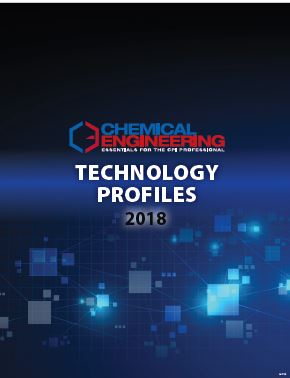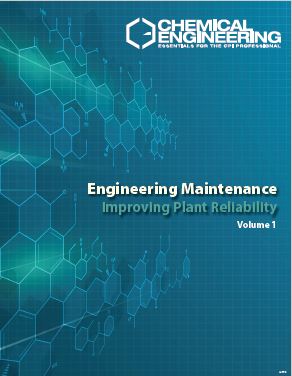| CHAPTERS: Chapter 1. Safeguarding process equipment; Chapter 2. Fire protection; Chapter 3. Safe operating procedures; Chapter 4. Hazard mitigation; Chapter 5. Instrumentation and diagnostics; Chapter 6. Safety-related data and calculations; Chapter 7. Worker training and protective gear |
| Protect plants against overpressure |
Wing Y. Wong, UOP LLC |
| Forestall pipe bursts |
David Copenhaver, Lawrence Coppari and Steve Rochelle, Eastman Chemical Co. |
| Save pipes from bursting with a compensator |
Jack Boteler, Flowguard USA, and David Clucas, Flowguard Ltd. |
| The use of certified KR for rupture disks |
Jeff Scoville, Oseco |
| Checking up on the rupture disk holders |
John Reynolds, Oklahoma Safety Equipment Co. (Oseco) |
| Emergency relief system design: In case of fire, break assumptions |
Dilip Das, Bayer CropScience |
| Properly size pressure-relief valves for two-phase flow |
Ron Darby, Texas A&M University, Freeman Self, Bechtel, and Vic Edwards, Kvaerner Engineers and Constructors |
| Specify the right-sized relief valve |
Virgini Carillo, Whesso Varec |
| Control the differential pressure on the PRV inlet line |
Wing Y. Wong, WYWong Engineering |
| Using the ideal gas specific heat ratio for relief-valve sizing |
Aubry Shackelford, Berwanger |
| Safe scaleup of exothermic reactions |
Jasbir Singh, Hazard Evaluation Laboratories, Inc. |
| Avoiding runaway reactions |
Bob Venugopal, Chilworth Technology |
| Runaway reactions: Ignore the chemistry at your peril |
David Leggett, Wilfred Baker Engineering |
| Accommodating potential reactions |
Edward Steve, CDI Engineering Group |
| Prevent thermal runaways in carbon beds |
Thomas Hofelich, Marabeth LaBarge and Denise Drott, Dow Chemical Co. |
|
| Don’t get burned — Know the limits of flammable and combustible fluids |
Mike Schmidt, EmersonProcess Management |
| Improve the fire protection of pressure vessels |
Wing Y. Wong, UOP LLC |
| An exercise in fire protection |
Fred Ashmore, International Fire Investigators and Consultants |
| Developing a sound safety program |
Raymond Jasniecki, Westinghouse Safety Management Solutions |
| Process safety management: Minimizing the need for shutdown |
John Sharland, FM Global |
| Zeroing in on workplace safety |
Michael McSherry, Foster Wheeler Environmental Corp. |
| Incident analysis can lighten the PSM burden |
Edward Clark, HSB Reliability Technologies |
| Engineering process safety |
Ian Sutton, Fluor Daniel |
| Enhancing safety through risk management |
Georges A. Melhem and R. Peter Stickles, Arthur D. Little, Inc. |
| Viewpoints on implementing inherent safety |
David Mansfield, AEA Technology |
| Teamwork manages risks more effectively |
Mark Templeton, Tennessee Eastman Div., Eastman Chemical Co. |
| Optimizing the CPI’s most valuable safety asset |
Christian Jochum, Carsten Henschel and Rudiger Hofmann, Hoechst AG |
| Conducting a process plant safety audit |
Ian Duguid, Consultant |
| Improving plant reliability: Look beyond the usual suspects |
Donald Schneider, Stratus Engineering |
| The road to zero accidents |
Steve Kemp, Occidental Chemical Corp., and Jan Sieving, Occidental Petroleum Corp. |
| Streamline your facility’s emergency-response plans |
Adam Steinman, Woodard & Curran |
| Normalize deviation at your peril |
Kenneth P. Bloch and Stephanie A. Williams, Flint Hills Resources |
| Emergency planning: Expect the unexpected |
Ray Jasniecki, Washington Safety Management Solutions |
| Process security management: Assess the threats, control the risk |
Edward Marszal, Exida |
| Process security management: Set up your plant’s program |
Paul Baybutt, Primatech |
|
| Safe handling of potent compounds – Part 1 |
Terrence Fay and Nicholas Phillips, Lockwood Greene |
| Safe handling of potent compounds – Part 2 |
Terrence Fay, Nicholas Phillips and Jarema Kraus, Lockwood Greene |
| Pyrophoric materials: Handle carefully |
Jeff Smith, Day & Zimmerman International |
| Safe, efficient handling of acids – Part 1 |
Stanley Grossel, Process Safety & Design |
| Safe, efficient handling of acids – Part 2 |
Stanley Grossel, Process Safety & Design |
| Removing H2S from gas streams |
Gary Nagl, U.S. Filter Gas Technology Products |
| Extremely hazardous substances’ — A focus on safer operations |
George Kinsley, Environmental Resources Management |
| Reduce toxic hazards using passive mitigation |
Stefanie Flamberg, Kimberly Torti and Philip Myers, ERM-Four Elements, Inc. |
| Abating halogenated VOCs |
Robert Keller and James Dyer, DuPont Co. |
| Managing emissions during hazardous-waste combustion |
Craig Doolittle, John Woodhull and Mudumbai Venkatesh, ENSR International |
| VOC control: Managing hazardous waste containers |
Karen Hamel, New Pig Corp. |
| Exploring VOC control options |
Jeffrey H. Siegell, Exxon Research and Engineering Co. |
| Destroying gaseous emissions: Pick the right thermal oxidizer |
Mudumbai Venkatesh and John Woodhull, ENSR Corp. |
| Contain & control emissions of ultrapure gases |
Gerald Dornblaser, Bob Phillips and D. Bruce Wilson, BOC Edwards |
| VOC control: Thermal vs. catalytic oxidation |
Stan Mack, Engelhard Corp. |
| Design & operate flares safely |
Ajay Kumar, The Sapphire Group |
| Clearing the air about flare systems |
John F. Straitz III, NAO, Inc. |
| Safety aspects of pneumatic conveying |
David Mills, Consultant |
| Reduce electrostatic hazards |
Vahid Ebadat, Chilworth Technology |
| Dust explosions: Is your safety blanket in place? |
Vahid Ebadat and Chantell Laing, Chilworth Technology |
| Dust collection in the CPI |
Tom Siljkovic, TS Consulting |
| Protect against rotating equipment loss: Steam turbines |
Edward E. Clark, The Hartford Steam Boiler Inspection and Insurance Co. |
| Protect against rotating equipment loss: Compressors, gas turbines, engines, motors |
Edward E. Clark, The Hartford Steam Boiler Inspection and Insurance Co. |
| Safety instrumentation systems: How much is enough? |
Barry Lytollis, MTL, Inc. |
| Design safety instrumented systems with relevant data |
Mark Menezes, Rosemount , and Steve Brown, DuPont |
| Improve plant safety through advanced measurement diagnostics |
Mark Menezes, Rosemount, Inc. |
| Toxics and combustibles: Designing gas-detection systems |
Long Pham, Moraes/Pham & Associates, and Daniel Pryor, EIT Gas Detection Systems |
| Survey your options: Continuous emissions monitoring |
John R. White, KVB/Analect |
| For effective gas detection, location counts |
Jay J. Jablonski, HSB Professional Loss Control |
| Comparing catalytic vs. infrared gas monitors |
Alan Austin, General Monitors |
| Protect workers and the environment: Choosing fixed-point gas sensors |
Alan Austin, General Monitors |
| Take this safety database to heart |
Ian Duguid, Consultant |
| Estimating the lower explosive limits of waste vapors |
Harold L. Shelton, Con-Serve, Inc. |
|
|
| Quick estimates for hazardous-gas releases |
Ajay Kumar, Sandi Wiedenbaum and Michael Woodman, EA Engineering, Science and Technology, Inc. |
| Estimating hazard distances from accidental releases |
Ajay Kumar, The Sapphire Group |
| Estimate emissions from atmospheric releases of hazardous substances |
Ajay Kumar, EA Engineering, Science and Technology, Inc. |
| Solubility & Henry’s Law constants for sulfur compounds in water |
Carl Yaws, Praveen Bajaj, and Harman Singh, Lamar University, Ralph Pike, Louisiana State University |
| Solubility and Henry’s Law constants for amines in water |
Carl Yaws, Jack Hopper and Sunil Mishra, Lamar University |
|
|
|
|
| Preparing employees for spill response |
Karen Hamel, New Pig Corp. |
| Do twelve-hour shifts answer your scheduling needs |
Steve Mardon, Circadian Technologies, Inc. |
| Help workers cope with heat stress |
John O’Grady, American Management Systems |
| Suiting up for safety in hazardous workplaces |
James Zeigler, Thomas Neal and Norman Henry, DuPont Co. |
| Reusing chemical-cartridge respirators |
Craig Colton, 3M |
| Safety showers and eyewashes: Design them right |
Joseph Deiss, IDC Engineers |
| Help workers cope with heat stress |
John O’Grade, American Management Systems
|




